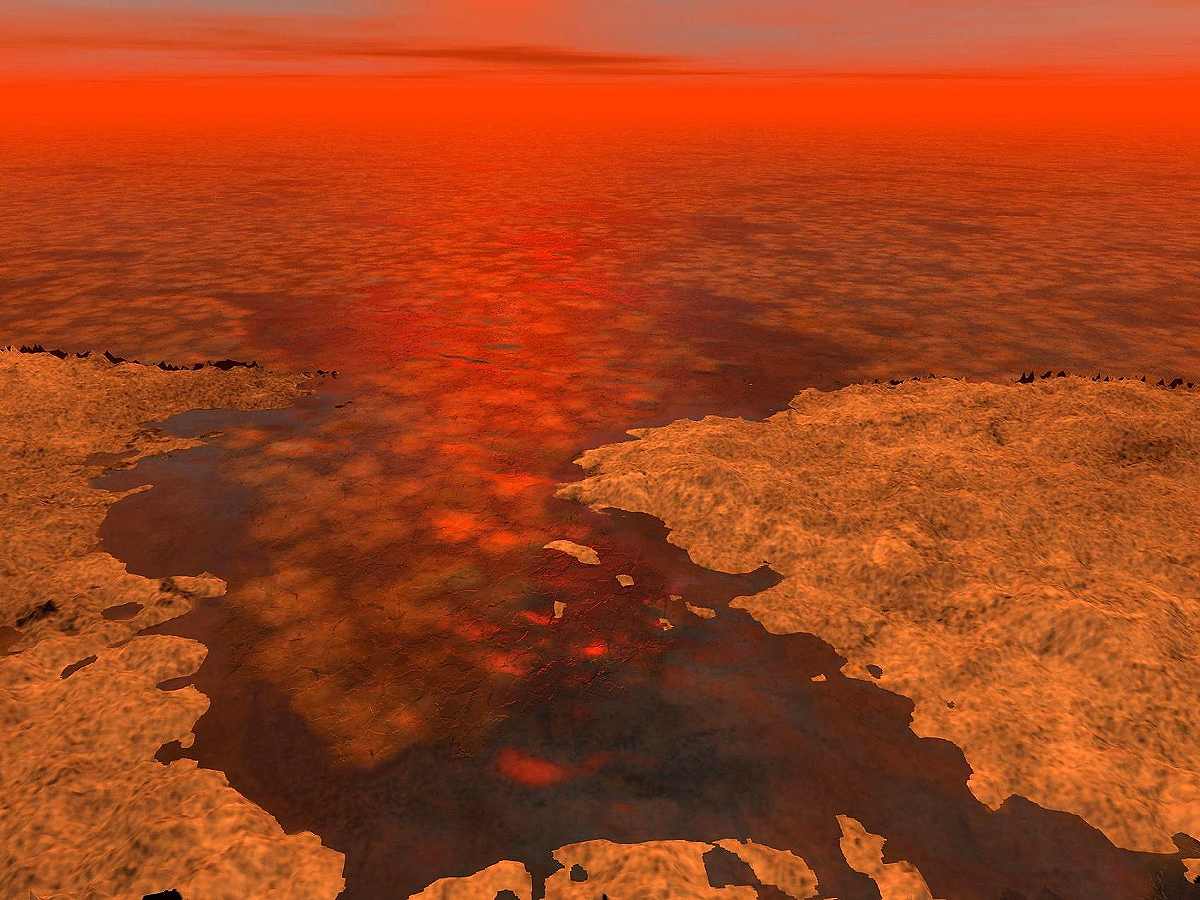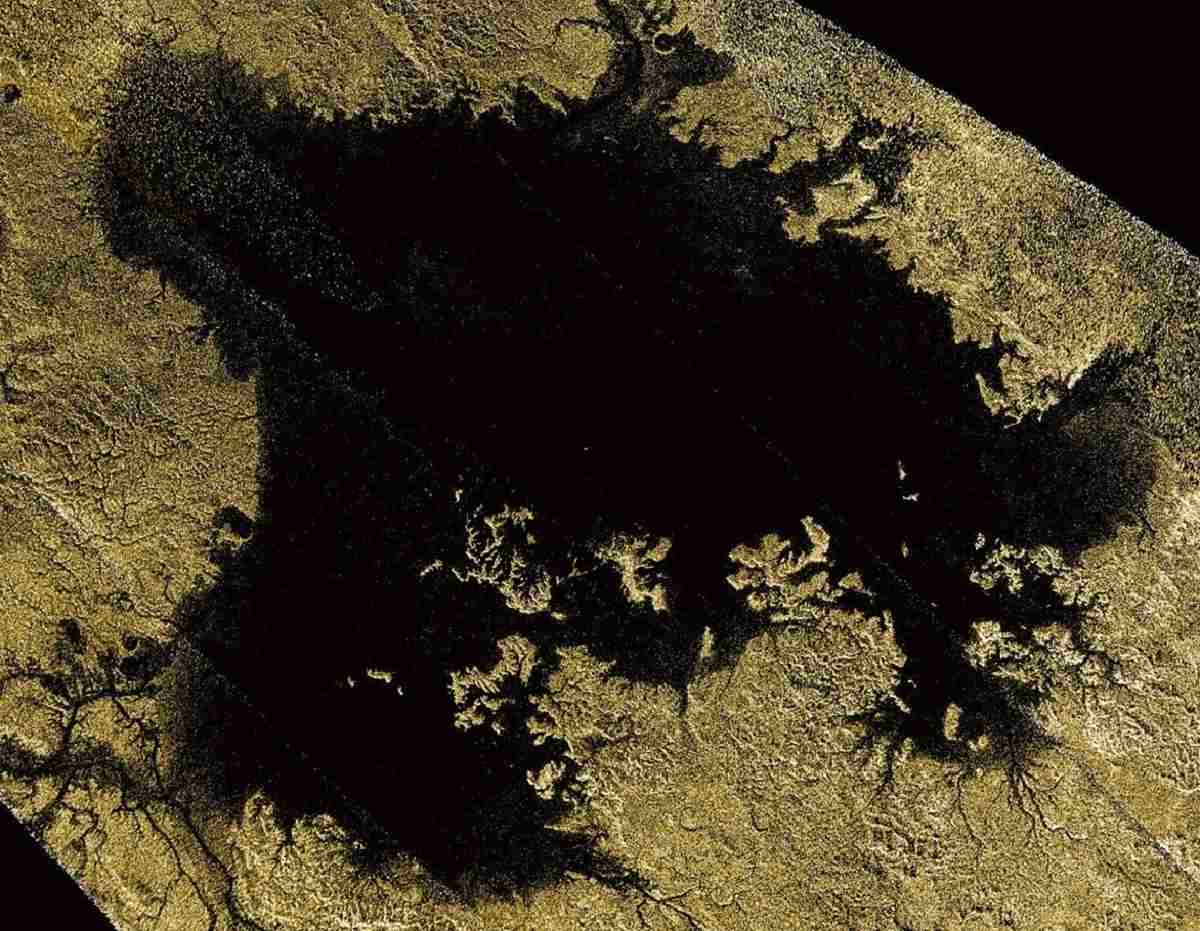

Left: An artist’s concept, released in January 2013, shows what hydrocarbon ice forming on a liquid hydrocarbon sea of Saturn’s Titan might look like. Right: Ligeia Mare, the second-largest known body of liquid on Saturn’s moon Titan, is seen in this image released in January 2018.
12:33 JST, July 27, 2024
WASHINGTON (Reuters) — NASA’s Cassini spacecraft, which explored Saturn and its icy moons, including the majestic Titan, ended its mission with a death plunge into the giant ringed planet in 2017. But some of the voluminous data gathered by Cassini during its 13 years of surveying the Saturnian system is only now being fully examined.
Cassini’s radar observations are providing intriguing new details about the seas of liquid hydrocarbons on the surface of Titan, our solar system’s second-largest moon and a place of interest in the search for life beyond Earth.
Titan, shrouded in a smog-like orange haze, is the only known world other than Earth exhibiting liquid seas on the surface, though they are not composed of water but rather nitrogen and the organic compounds methane and ethane, components of natural gas.
The study involved three seas near Titan’s north pole: Kraken Mare, the largest, covering an area comparable to Eurasia’s Caspian Sea; Ligeia Mare, the second-largest and comparable in area to North America’s Lake Superior; and Punga Mare, roughly equivalent to Africa’s Lake Victoria.
The chemical composition of these seas — methane-rich versus ethane-rich — was found to vary depending on their latitude. The study also documented the extent and distribution of sea surface ripples, indicating active tidal currents and increased roughness near estuaries — the mouths of rivers.
Titan, 5,150 kilometers wide, is our solar system’s second-biggest moon behind Jupiter’s Ganymede and is larger than the planet Mercury. Titan and Earth are the only worlds in the solar system where liquids rain down from clouds, flow as rivers into seas and lakes on the surface and evaporate back up to the sky to begin the hydrological process again.
On Earth, water rains down from clouds. On Titan, clouds spew methane — which is a gas on Earth — in liquid form due to the frigid climate.
“Titan is really an Earth-like world with a diverse set of very familiar surface morphologies shaped by a methane-based hydrologic system operating in a dense nitrogen atmosphere,” said Cornell University engineer and a planetary scientist Valerio Poggiali, lead author of the study published on July 16 in the journal Nature Communications.
“Seas and lakes of liquid hydrocarbons dot the surface in the polar regions, especially the northern one. Precipitation-fed channels flow into these seas creating estuaries, in some cases deltas,” Poggiali added.
The Cassini data indicated the rivers carry pure liquid methane that then mixes into the more ethane-rich liquids of the seas, much as freshwater in Earth’s rivers mixes into saltwater oceans.
“Titan’s seas are pulled by Saturn’s massive gravity, just like our seas, and the tidal range on some of its shorelines may be around 30 centimeters. Because the tidal period — Titan’s day — is long, 16 Earth days, the tidal cycle is slow, so the tidal currents are generally weak,” said planetary scientist and study coauthor Ralph Lorenz of the Johns Hopkins University Applied Physics Laboratory.
The study used “bistatic” radar data collected during Cassini flybys of Titan, three in 2014 and one in 2016. Cassini aimed a radio beam at targets on Titan’s surface, which then reflected toward a receiving antenna on Earth. This provided richer information about the composition of the reflecting surface and its roughness than ordinary Cassini “monostatic” radar, which bounces a radio signal off a target and back to the point of origin.
“This is likely the last untouched dataset that the Cassini spacecraft left us,” Poggiali said.
Titan boasts environments with conditions considered potentially suitable for life. For instance, Titan appears to harbor a vast subsurface ocean of liquid water.
“Are the heavy organic molecules produced in Titan’s atmosphere prebiotic in nature?” Poggiali asked, referring to chemistry that could led to formation of life. “Has all this organic material ever been in contact with liquid water? We believe that similar interactions could have led to the origin of life on our planet, with the generation of molecules able to produce energy or store information.”
"Science & Nature" POPULAR ARTICLE
-

Genome Study Reveals Milestone in History of Cat Domestication
-

Big Leap in Quest to Get to Bottom of Climate Ice Mystery
-

Japan Set to Participate in EU’s R&D Framework, Aims to Boost Cooperation in Tech, Energy
-

Paws on Parade: Nairobi’s Dogs Dazzle at ‘Pawchella’
-

Japan’s H3 Rocket Failed in Latest Launch, Says Official
JN ACCESS RANKING
-

Tokyo Economic Security Forum to Hold Inaugural Meeting Amid Tense Global Environment
-

Keidanren Chairman Yoshinobu Tsutsui Visits Kashiwazaki-Kariwa Nuclear Power Plant; Inspects New Emergency Safety System
-

Imports of Rare Earths from China Facing Delays, May Be Caused by Deterioration of Japan-China Relations
-

University of Tokyo Professor Discusses Japanese Economic Security in Interview Ahead of Forum
-

Japan Pulls out of Vietnam Nuclear Project, Complicating Hanoi’s Power Plans























